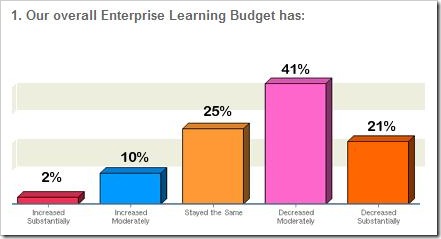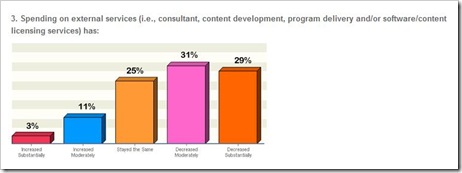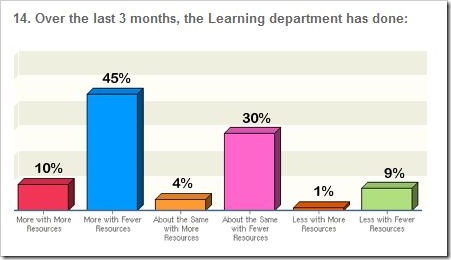This is a very strange time. While increasing amount of concept work and the pace of change puts a premium on learning, the business of learning faces an incredibly difficult time. In the past few weeks, I've had some really eye-opening conversations about the state of Learning as a Business. It makes me realize that we had really better get moving on thinking about our collective future. There are some important calls to action at the bottom of this post.
Particularly, I'm interested in the question of:
While training as a publisher of courses and courseware faces an increasingly challenging market,
what other things can learning businesses successfully sell to internal or external customers?
Troubled Times for Publishers
By way of background for this, I think it's instructive to look at what is happening in parallel industries. Publishing happens to be a pretty close parallel to training. The challenges for publishers has been well documented:
- From Terrible to Terrifying: “The stats show that total newspaper ad sales dropped by an unprecedented 28.28% in the first quarter of 2009, a deep plunge that represents a loss of more than $2.6 billion in ad revenue compared year-over-year.”
- Newspapers and Thinking the Unthinkable by Clay Shirky "...the core problem publishing solves — the incredible difficulty, complexity, and expense of making something available to the public — has stopped being a problem."
- New Yorker – Out of Print
Few believe that newspapers in their current printed form will survive. Newspaper companies are losing advertisers, readers, market value, and, in some cases, their sense of mission at a pace that would have been barely imaginable just four years ago. Bill Keller, the executive editor of the Times, said recently in a speech in London, “At places where editors and publishers gather, the mood these days is funereal. Editors ask one another, ‘How are you?,’ in that sober tone one employs with friends who have just emerged from rehab or a messy divorce.” Keller’s speech appeared on the Web site of its sponsor, the Guardian, under the headline “NOT DEAD YET.”
Watch this following video from the Daily Show:
Great lines - "You guys are like a walking Colonial Williamsburg." At 3:23 - "Give me one thing in there that happened today." The reaction is priceless. "What's black and white and red all over. Your balance sheet."
The editor at the end makes a great point that you don't find a Huffington Post, Drudge over reporting in Iraq. It reminds me a bit of the arguments about the loss of quality as you lose our instructional design and go to cheaper forms of delivery. But that doesn't mean you have a viable business.
State of the Business of Learning
Oh, those poor publishing people. Thank goodness that's not us. FYI that's what publishers thought about the music industry when it when through it's slide. That may be happening right now when we (learning businesses) look at publishing.
I don't think there's much doubt that we are in a very tough period for learning businesses. Take a look at the Masie – Learning Barometer.



Learning budgets are decreasing. Spending on external services are decreasing even more. And learning departments need to do more with fewer resources.
If you are inside a corporate learning department, assuming you still have your job, then you feel this by being more busy. In many ways, that's not a bad feeling compared to either the person who lost their job. Or the people who have seen their learning business crushed by this. Anecdotally times are incredibly tough right now for training vendors. See My business has cracked! for one first person story. But I've talked to training vendors who are down 30 – 60% on their sales in the first quarter. 60% lower sales is a really difficult thing to manage. You have fixed overhead.
Temporary Downturn or Changing Landscape?
While the market is tough right now, there are some people who believe that learning businesses who sell classroom, virtual classroom and courseware training will rebound once the economy rebounds. And maybe within some niches that's true.
I personally believe that traditional training as publishing is on an overall downward trend. I'm certainly not alone. When we asked the Big Question of Workplace Learning in 10 Years – the responses of many experts were that in 10 years there would be significantly shift from classroom to eLearning and virtual classroom, but combined total training dollars spent on traditional formal learning will be less in ten years.
You can certainly argue against this being the case. And probably the best argument comes from the fact that learning needs are greatly increasing. Of course, the crux of the issue is whether those needs are being fulfilled through self-service learning or by formal training. I personally would bet against training as publisher of formal learning in the long-term.
Interestingly, I expected that the stock market – which generally I think of as being forward looking – would show bear this out. In other words, the stocks of public training companies would be down as compared to the market as a whole. Instead, it appears that the stock market considers these companies to be okay bets.

But when I drilled down on one company, Learning Tree, it's quarterly revenue from last year is down from $47M to $30.5M and it's running an operating loss from making $4M. That's a big ouch. And for smaller training businesses, it likely feels more painful than that. I'm not quite sure how the market can be treating them as well as they are.
However, I would be a bit worried about these stocks when I think about what has happened in No Bull: 2008 — The Year Newspaper Stocks Collapsed:
The statistics behind the collapse of newspaper stocks in 2008 are sobering as New Year’s Eve approaches:
GateHouse, down 99.55% in this calendar year
McClatchy, down 93.6%
Lee Enterprises, down 97.3%
Journal Register Co., down 99.58%
Media General, down 92.47%
Gannett, down 80%
I guess that's why I'm not a stock analyst.
There are pretty important question here to ask about your learning business:
- Will there be demand for our training products (classroom, virtual classroom, eLearning)?
- Is it generally going to be still growing or are we selling into a market that's contracting?
I always think it's good to go back to customers and what they are willing to pay for as a reality check. Put your customer hat on for a minute. Are you more or less interested today in taking a course on something? Do you remember 10 years ago when going to a five day course seemed great? Do you even consider that anymore?
Okay, I'm leading the witness, but I believe that you will find that most people are less interested in training as a product.
That said, I would still claim that because of the pace of change and the increasing number of concept workers …
There is an ever increasing need for learning.
Future of Learning as a Business
Weird times certainly. There's an increasing need for learning, but a demise of training. I can't say this is really anything new. The writing has been on the wall (or in blogs) for quite a while:
Jay Cross and Harold Jarche in The Future of the Training Department
The second half of the 20th Century was arguably the Golden Age of Training. Every corporation worth its salt opened a training department. Xerox Learning, DDI, Forum Corporation, and hundreds of other “instructional systems companies” sprung up. Thousands upon thousands of trainers attended conferences to learn about new approaches like programmed instruction, behavior modeling, roleplay, certification, interactive multimedia, sensitivity training. corporate universities, and Learning Organizations. Training was good; efficient training was better.
Future of Training Started Yesterday – Dave Wilkins – Mzinga
The gist: we need to completely rethink training departments and responsibilities from the ground up (both literally and figuratively) and we need to recognize that we are midst of a transition to a new normal.
…
This is similar to a post I wrote called Social Learning Defined where I argued that there were three models at play simultaneously: socializing existing formal models (top-down), the sharing of information “from the trenches” back to management (bottoms-up) and the sharing of best practices and collaborating (side-to-side).
…
All of this should scare the crap out of you if you are in learning.

This Venn Diagram courtesy of What Consumes Me captures the questions pretty well. I'm somewhat focused on the bottom right – what we can be paid to do and figure things out from there. Thus, the challenge I really see around all of this is:
What will internal or external customers pay for that's not traditional training?
In having lots of conversations with heads of training departments, training vendors, and training consultants, it's not at all clear what we should be selling instead.
Sure we know about software and services that go along with things like:
- Informal Learning
- Social Learning
- Toolkits
- Resource sites
- Books 24x7, Safari
But will people really pay for these things? Training is a known product. These things are not. And you are competing with a perception that there are free/open or public or cheap versions of all of these things. Or that someone can figure it out. Don't I just use SharePoint? If we start using social learning, do they really need anything from the learning department?
As one example of the challenge, Upside Learning (disclosure) who often works for training companies to help them build innovative eLearning Solutions has what they call an Innovation and New Projects Team. This team builds innovative solutions, often in concert with their training company partners, that they believe will help generate business. This is an applied R&D effort with the goal of building out things that customers will ultimately want to buy. That's worthy of a blog post on its own, but this topic raises and interesting question: What should the innovation team be building? Should they spend time building out things that are listed above? The safe bet is for them to build things that are closer to existing eLearning solutions. But that doesn't get us across the chasm.
We seem to be squarely in an Innovators Dilemma. One caution about the above Venn diagram is that it doesn't necessarily imply the disruptive changes that may be required here. Incremental changes, e.g., going from face-to-face in a classroom to virtual classroom or courseware, likely are not going to be sufficient in the long run.
Conclusion
Ending this with these somewhat terrifying questions is probably going to be a little bit unsettling. But I certainly don't claim that I have the answers to this. I've talked with enough VPs of Training and CEOs of Training Companies to know that this is a hard problem that definitely has their attention. And I don't see easy answers.
Maybe just because of my nature, I'm actually still optimistic because there's greater need for learning than ever before. I believe that we are in the learning business – and there must be things we can do. It's part of the reason for Work Literacy and Aggregage. These are small pieces to a larger question.
Calls to Action
I would like to ask you to help me pursue this topic:
1. If you have thoughts on this by all means comment or write a post or engage me in a conversation. It's too important not to discuss.
2. What business models, products, companies do you currently see getting ahead in this? Where should we collectively be looking to understand what's next? What's already selling?
3. I am planning to hold a discussion through Learn Trends around this topic in July. I'm going to bring together people who represent a variety of different perspectives for a frank discussion and exploration of the business of learning.
Learning Department Heads
- What can they sell internally that's not training? What will they pay for?
Training Companies, Software Vendors, Services Vendors
- What products and services are selling? Where are they going? What are the challenges?
More to come on this. I hope you will find this topic compelling enough to want to participate.
July 2009 Discussions
In July 2009, we held a
Free Online Conference – Future of Learning. You can see the
video recordings of the session.
Additional Reading
I used eLearning Learning to find some other great pieces on this topic:





